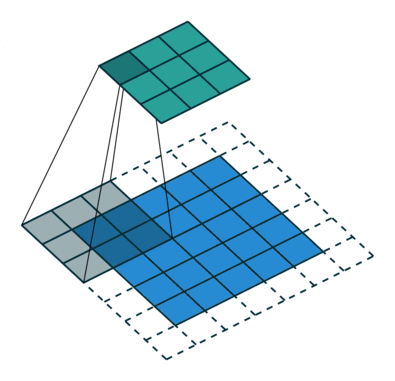Complex Convolution¶
Complex Conv 2D¶
Small code example
input_shape = (4, 28, 28, 3)
x = tf.cast(tf.random.normal(input_shape), tf.complex64)
y = ComplexConv2D(2, 3, activation='cart_relu', padding="same", input_shape=input_shape[1:], dtype=x.dtype)(x)
assert y.shape == (4, 28, 28, 2)
assert y.dtype == tf.complex64
-
class
ComplexConv2D¶ 2D convolution layer (e.g. spatial convolution over images). Support complex and real input.

This layer creates a convolution kernel that is convolved with the layer input to produce a tensor of outputs. If
use_biasisTrue, a bias vector is created and added to the outputs. Finally, ifactivationis notNone, it is applied to the outputs as well. When using this layer as the first layer in a model, provide the keyword argumentinput_shape(tuple of integers, does not include the sample axis), e.g.input_shape=(128, 128, 3)for 128x128 RGB pictures indata_format="channels_last".
-
__init__(self, filters, kernel_size, strides=(1, 1), padding='valid', data_format=None, dilation_rate=(1, 1), groups=1, activation=None, use_bias=True, dtype=np.complex64, kernel_initializer=ComplexGlorotUniform(), bias_initializer=Zeros(), kernel_regularizer=None, bias_regularizer=None, activity_regularizer=None, kernel_constraint=None, bias_constraint=None, init_technique: str = 'mirror', **kwargs)¶ Parameters: - filters – Integer, the dimensionality of the output space (i.e. the number of output filters in the convolution).
- kernel_size – An integer or tuple/list of 2 integers, specifying the height and width of the 2D convolution window. Can be a single integer to specify the same value for all spatial dimensions.
- strides – An integer or tuple/list of 2 integers, specifying the strides of the convolution along the height and width. Can be a single integer to specify the same value for all spatial dimensions.
Specifying any stride value != 1 is incompatible with specifying any
dilation_ratevalue != 1. - padding – one of
"valid"or “same” (case-insensitive). -"valid"means no padding. -"same"results in padding evenly to the left/right or up/down of the input such that output has the same height/width dimension as the input. - dtype – Dtype of the input and therefore layer. Default
complex64. - data_format – A string, one of
channels_last(default) orchannels_first. The ordering of the dimensions in the inputs.channels_lastcorresponds to inputs with shape(batch_size, height, width, channels)whilechannels_firstcorresponds to inputs with shape(batch_size, channels, height, width). It defaults to the image_data_format value found in your Keras config file at ~/.keras/keras.json. If you never set it, then it will bechannels_last. - dilation_rate – an integer or tuple/list of 2 integers, specifying the dilation rate to use for dilated convolution. Can be a single integer to specify the same value for all spatial dimensions.
Currently, specifying any
dilation_ratevalue != 1 is incompatible with specifying any stride value != 1. - groups – A positive integer specifying the number of groups in which the input is split along the channel axis. Each group is convolved separately
with
filters / groupsfilters. The output is the concatenation of all thegroupsresults along the channel axis. Input channels andfiltersmust both be divisible bygroups. - activation – Activation function to use. If you don’t specify anything, no activation is applied (see
keras.activationsorcvnn.activations). For complexdtype, this must be acvnn.activationsmodule. - use_bias – Boolean, whether the layer uses a bias vector.
- kernel_initializer – Initializer for the
kernelweights matrix (seecvnn.initializers). - bias_initializer – Initializer for the bias vector (see
cvnn.initializers). - kernel_regularizer – Regularizer function applied to the
kernelweights matrix (seekeras.regularizers). - bias_regularizer – Regularizer function applied to the bias vector (see
keras.regularizers). - activity_regularizer – Regularizer function applied to the output of the layer (its “activation”) (see
keras.regularizers). - kernel_constraint – Constraint function applied to the kernel matrix (see
keras.constraints). - bias_constraint – Constraint function applied to the bias vector (see
keras.constraints). - init_technique –
String. One of ‘mirror’ or ‘zero_imag’. Tells the initializer how to init complex number if the initializer was tensorflow’s built in initializers (not supporting complex numbers).
- ’mirror’ (default): Uses the initializer for both real and imaginary part. Note that some initializers such as Glorot or He will lose it’s property if initialized this way.
- ’zero_imag’: Initializer real part and let imaginary part to zero.
Warning
ATTENTION: regularizers not yet working, that parameter will be ignored.
-
call(self, inputs)¶ - Calls convolution, this function is divided in 4:
- Input parser/verification
- Convolution
- Bias
- Activation Function
Parameters: inputs – Input tensor, or list/tuple of input tensors. Returns: A tensor of rank 4+ representing activation(conv2d(inputs, kernel) + bias).
Complex Conv 1D and 3D¶
This library also has 1D (ComplexConv1D) and 3D (ComplexConv3D) convolution layers.
Usage is analogous to ComplexConv2D.